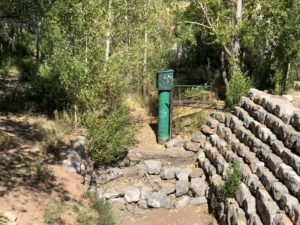Luke Runyon had a piece over the weekend about the latest Bureau of Reclamation 24-month study, the increasingly bleak monthly modeling run that shows Colorado River reservoir levels dipping and diving in a way that the Metropolitan Water District of Southern California’s Jeff Kightlinger described thus:
“We’re in uncharted territory for the system,” says Jeff Kightlinger, general manager of the Metropolitan Water District of Southern California, the water wholesaler for the greater Los Angeles area, which relies on the Colorado River for a portion of its supplies.
“Everything is new, and it is all bleak. None of it is positive,” Kightlinger says.
In one of those small world coincidences, I was on a bike ride yesterday afternoon, wandering downtown Santa Fe, New Mexico, and bumped into (figuratively) Kightlinger. I interrupted his cell phone conversation to say “hi”, and he told me he was on the phone with Pat Mulroy, because of course on a nice warm Santa Fe afternoon one bumps into the Colorado River brain trust, connected.
Not so coincidental, really. Kightlinger and I converged with other Colorado River folks on Santa Fe for an Upper Colorado River Commission meeting this week. A bunch of side meetings are also underway to, in the words of one of the convergents, “try to jump start” the stalled Drought Contingency Plan discussions.
 Kightlinger’s right about the “uncharted territory” thing. The DCP is an effort to cobble together a map of the water management terrain ahead as we’re speeding toward – well, speeding toward something that we’re not quite sure what it is but it’s probably really bad.
Kightlinger’s right about the “uncharted territory” thing. The DCP is an effort to cobble together a map of the water management terrain ahead as we’re speeding toward – well, speeding toward something that we’re not quite sure what it is but it’s probably really bad.
My main reason for tagging along to the Santa Fe meetings is the chance for some “side meeting” time with Eric Kuhn, my collaborator on a new book that is looking closely at how we got here. In particular, we’re looking at the “charts” (to borrow Kightlinger’s metaphor) that we did make beginning with the 1922 Colorado River Compact – the rules guiding how we would develop the river’s water, and our hydrologic understanding that was used to draw them. The reason this is so “uncharted” is because we (they?) didn’t do a good job at all of contemplating the “what if” scenario of river less than their rosy planning assumptions of a booming Colorado River with surpluses for all.
In fact, the framers did make a roadmap of sorts, with the Colorado River Compact’s long forgotten article III(f):
(f) Further equitable apportionment of the beneficial uses of the waters of the Colorado River System unapportioned by paragraphs (a), (b), and (c) may be made in the manner provided in paragraph (g) at any time after October first, 1963, if and when either Basin shall have reached its total beneficial consumptive use as set out in paragraphs (a) and (b).
So bad were their maps at the time that they actually thought there was not only plenty of water for full development of the farms and cities we now see, but that they would have to reconvene in 1963 to parcel out an additional allocation of more water!
By 1963, there was not only no discussion of a surplus, but active discussion of how to cope with the fact that there wasn’t enough water for even the basic allocations laid out in the compact. And yet, here we are today, 50 years later (and a nearly century after the compact was signed), still with no chart.
In addition to my happy accident of bumping into Kightlinger, I rode past a gauge on the Santa Fe River just downstream from downtown Santa Fe, forlornly waiting for water to measure. It was an omen, a nice literary device to support my hope that the DCP jump starting yields some progress this week.

Yes they thought there would be enough water for additional allocations by mid-century, but they (or at least some) also thought that future generations would need to reevaluate the entire agreement. I think this is a pretty telling comment from Hoover in 1926:
“It seems to me almost fantastical to be fighting the shadows of what may happen under these circumstances 75 years hence. Suppose we had endeavored in 1850 to determine and settle for today what would have been the best solution of any of a hundred problems. For instance, Faraday’s great discovery in electrical induction, from which the whole electrical development of the world has sprung – who could have foreseen its effect on the best solution. I am one of those who have a great deal of confidence that all anticipations over physical questions inevitably bend themselves to the forces of the life and that if we can provide for equity for the next 40 to 75 years we can trust to the generation after the next to be as intelligent as we are today. They will settle it in the light of the forces of their day.”
This is all to say I’m very much looking forward to your and Eric’s new book!
Seems tha JW Powell would get a kick out of comments like. “uncharted territory “ regarding the lack of water / rainfall.
Pingback: Blog: ‘We’re in uncharted territory’ | H2minusO Blog